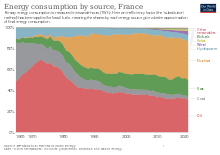

According to the International Energy Agency, France has historically generated a very low level of carbon dioxide emissions compared to other G7 economies due to its reliance on nuclear energy.[1] Energy in France was generated from five primary sources: nuclear power, natural gas, liquid fuels, renewables and coal. In 2020, nuclear power made up the largest portion of electricity generation, at around 78%. Coal energy is declining and due to cease.[2] Renewables accounted for 19.1% of energy consumption in 2020.[2] France has the largest share of nuclear electricity in the world.[3] The country is also among the world's biggest net exporters of electricity. The country is increasingly investing in renewable energy and has set a target of 32% by 2030.[4]
In its 2021 Country report on France, the International Energy Agency warned that the country is recording delays in terms of meetings its own energy and climate goals.[5] The IEA pointed to the rising level of carbon emissions due to the reliance on fossil fuels in transport in particular and to concerns related to the aging nuclear fleet.[1]
- ^ a b "France 2021". iea. International Energy Agency. November 2021. Retrieved 24 February 2022.
- ^ a b Bauer-Babef, Clara (2021-05-06). "France trailing behind EU renewable energy goals". www.euractiv.com. Retrieved 2021-09-09.
- ^ "Nuclear Share of Electricity Generation in 2018". IAEA. Retrieved 26 October 2019.
- ^ "Renewable Energy In France; What You Should Know". Hive Power. 2021-06-07. Retrieved 2021-09-09.
- ^ Collen, Vincent (30 November 2021). "Transition énergétique : la France « en retard » sur ses objectifs". Les Echos (in French). Retrieved 24 February 2022.